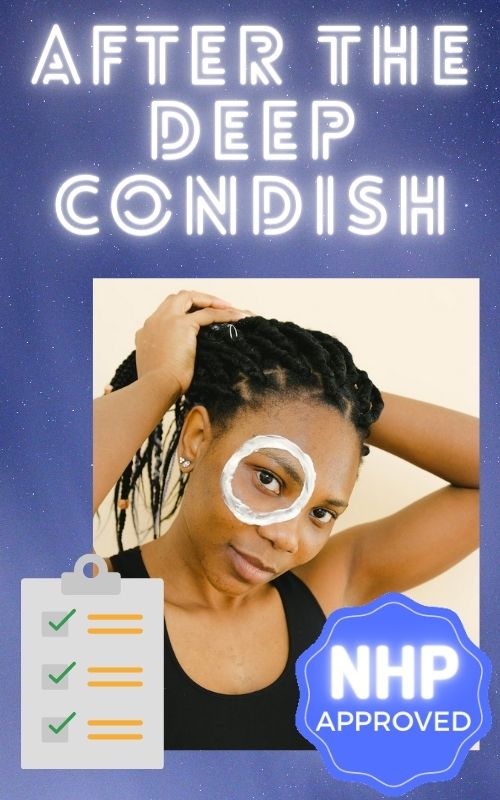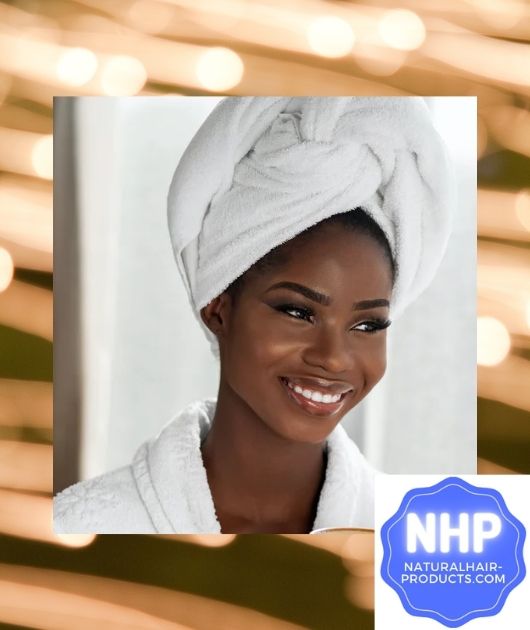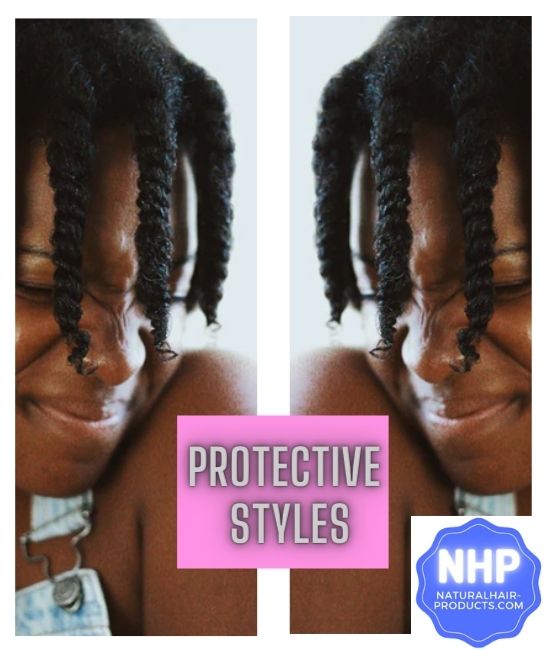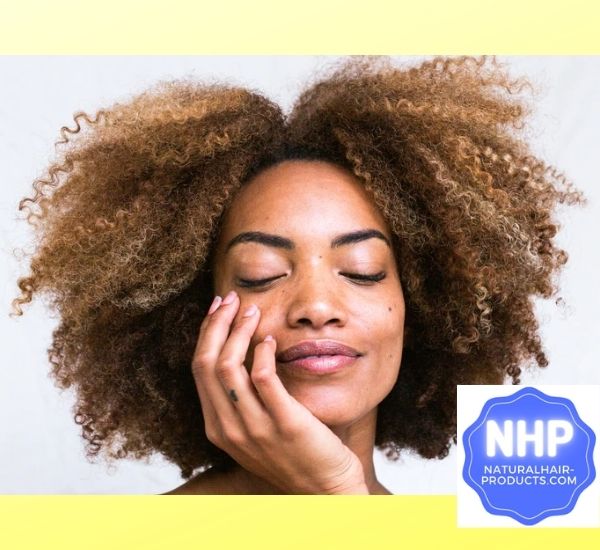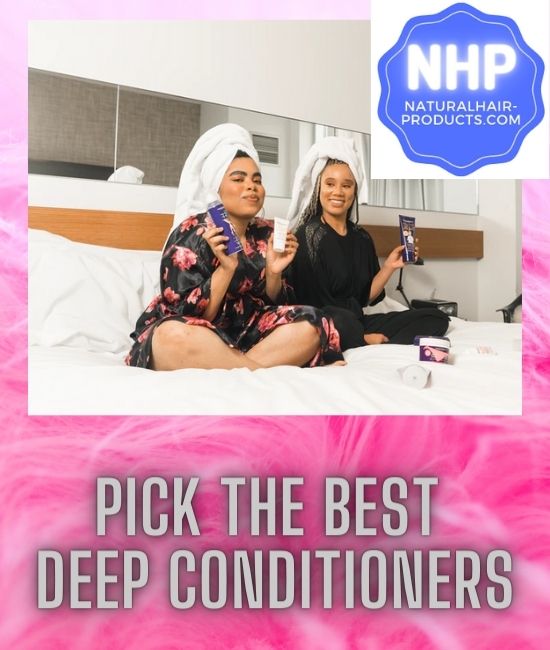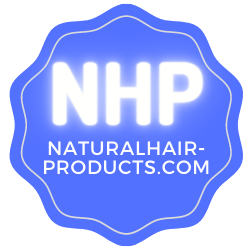What To Do After Deep Conditioning Natural Hair
- NHP
- Type 4C Hair 101
- What to Do After Deep Conditioning Natural Hair
Let’s talk about EXACTLY what to do after deep conditioning natural hair, particularly types 3C-4C.
Alright, so let’s imagine that you’ve deep conditioned your luscious natural hair with the best deep conditioner available already.
Now it’s time to seal the deal with the proper post deep-conditioning steps for the best-looking, safest and healthiest hair possible after your wash day of triumph.
Do you just go back and do what you would normally do before you made deep conditioning a staple in your wash day routine?
Or are you supposed to create a strategic hair care regimen just because you have deep conditioned?
Let’s talk about this situation in detail. NHP style…. :-)
What To Do After Deep Conditioning Natural Hair [QUICK LIST]
If you don’t have time for in-depth answers, let me get straight to the point for you. If you’ve asked, “What to do after deep conditioning natural hair?”.
Here’s the answer, after deep conditioning natural hair you should:
- Rinse hair with cool water to seal cuticles.
- Keep your natural hair fully moisturized!
- Always use a water-based leave-in conditioner.
- Air-dry natural hair or be cautious with the use of direct heat.
- Wear protective hairstyles.
- Understand the difference between shedding and breakage.
- Keep your natural ends trimmed.
- Protect your hair with satin or silk overnight.
- Exercise and eat a hair-healthy diet rich in vitamins and minerals.
Now, if you’re the type that loves to have details continue reading for the full breakdown of the after deep condish procedure blueprint.
[RELATED ARTICLE: Should you pre-poo relaxed hair?]
What To Do After Deep Conditioning Natural Hair 3C-4C [DETAILED EXPLANATION]
So here are the details about what to do after deep conditioning natural hair 4C-to-3C… These 9 steps are critically important for getting the best results and longest lasting styles after wash day.
These routine steps are also a great length-retention and hair growth practice.
[RELATED ARTICLE: What does a deep conditioning treatment do?]
1. Rinse hair with cool water to seal cuticles.
The absolute first thing you should do after deep conditioning natural hair is getting that cold water splashing for the rinse out process. If desired, you can start off with a bit of warm water but the final rinse should be with cool water to close the hair cuticles which help the strand hold in hydration. This is also a perfect time to do an ACV Rinse.
Why?
Because apple cider vinegar rinses work as a clarifying agent, this helps to remove some types of product build-up from the hair while also sealing up the hair cuticles.
This is critically important because if your hair cuticles are left in an “open” position, it makes the hair strand look dull, lifeless and feel rough to the touch.
Since hair naturally has a slightly acidic pH, the chemical makeup of ACV rinses are effective at helping close the hair cuticle and locking in moisture.
ACV rinses are also great to do after deep conditioning 4C natural hair because it promotes blood circulation in the scalp–which can stimulate new hair growth, promote length-retention, and give your bouncing kinks and curls a brilliantly soft, healthy sheen.
2. Keep your natural hair fully moisturized!
After deep conditioning natural hair you must layer on the moisturization. Dry hair breaks quick as all get-out - so why need to kick dryness in the butt while our deep conditioner has it against the ropes! For hair health, hair growth and the cutest looks, t is critical that you keep your natural hair moisturized at all times.
Because the ends of your hair are the oldest and most weathered parts of the strand, they are far more prone to splitting and breakage. Because of this breakage threat you should focus on moisturizing and sealing your ends daily.
3. Always use a water-based leave-in conditioner.
After applying a high-quality water-based moisturizer like Ouidad's Moisture Lock premium leave-in conditioner, seal the hydration and moisture in with an oil and/or hair butter to maintain high hydration levels over the next couple of days.
If most leave-in conditioners weigh your hair down, another alternative is light hair milk for curly hair – this is good if you’re looking for something more lightweight, so you don’t have to worry about weighing natural hair down with rapid product build-up.
Be consistent with your hair moisturizer to keep your hair hydrated in between your wash days, or in between treatments.
You may want to wet your hair before applying moisturizers for maximum effect!
Most moisturizers are actually water-based, so using these while your hair is wet can help retain as much moisture as possible.
4. Air-dry natural hair or be cautious with the use of direct heat.
Air drying your natural hair is the safest method to use after deep conditioning, if you have enough time on your hands. You can speed the process up with some cool blow drying.
When it comes to intense heat, try to avoid it. For goodness sake, run from hot pressing combs which can easily burn your hair to a nice and scorched crisp. And be sure to never put a flat iron to your wet hair even if you own a gentler tourmaline or ceramic straightening iron.
Although using heat can have its place in a 4C hair regimen without being disastrous, many natural hair sistas sometimes misjudge how damaging heat can be with repeated and long-term use. The use of direct heat is very likely to cause some level of heat damage at some point.
If you're going to use heat after deep conditioning natural hair, remember to always apply a quality heat protectant before using heat. Flat iron heat should only be used on clean, dry hair.
5. Wear protective hairstyles.
After deep conditioning natural 4C hair you can always turn to using protective hairstyles in order to protect the ends of the hair which are the oldest, most worn-out and more prone to breakage.
When wearing a protective hairstyle the hair ends are tucked away, which guards them from rubbing against your blouse or shirt collar and/or being exposed to heat, the sun, or cold drying air.
Protective hairstyles such as flat twists, braids, buns, updos, weaves, two-strand twists, or any style that helps to protect the ends of your hair are great to do after deep conditioning natural hair.
Protective styling is also a great tactic for maintaining growth retention.
6. Understand the difference between shedding and breakage.
After deep conditioning look for fallen hairs in your sink and towel. If you see a hair follicle (a tiny white bulb) at the end of a fallen hair strand, this is a sign of normal shedding from your scalp.
If you don’t see the follicle this is a likely signal that you’re suffering unnatural hair breakage.
7. Keep your natural ends trimmed.
To fight against unnatural hair breakage you should keep your natural ends trimmed.
You can safely clip your ends every 3-6 months.
If you are natural and wearing color, you may be better served by trimming a bit more frequently to prevent breakage.
8. Protect your hair with satin or silk overnight.
After deep conditioning natural hair you should always sleep in a satin/silk bonnet or headscarf, or use a satin/silk pillowcase.
Sleeping with a cotton pillowcase or scarf will suck the moisture and products out of your hair and cause it to dry out fast.
That happens because cotton is very absorbent, it’s also more abrasive against your hair than satin and silk.
That excessive friction and manipulation between your hair and cotton fabrics leads to dryer and unhealthier hair in the morning.
9. Exercise and eat a hair-healthy diet rich in vitamins and minerals.
Both before AND after deep conditioning natural hair, you should aim to drink lots of water which will benefit your hair and entire body.
A great hair and body health tip is to switch from white salt, which is bad for you because it’s only sodium and chloride over to gray Celtic or pink Himalayan sea salt, which is actually good for you because they have the full spectrum of minerals.
If your body is dehydrated then so is your hair, so drink your water, get your minerals and eat more veggies. Exercise also helps your blood circulation flow smoothly!
What To Do After Deep Conditioning Natural Hair BONUS: Try Oils Only
Want a bonus tip for what to do after deep conditioning natural hair? Here it is… you can bless your 3C-4C natural hair by testing an oil only method.
You can try to follow up your deep conditioner with only oil or layer oil on top of your hair moisturizer product or leave-in conditioner.
In simple terms, oils help seal your kinky curly 3C-4C hair which reduces the rate of hydration loss and moisture depletion.
Oils are great in the moisturization process because they work to seal in moisture from water and leave-in conditioners while also infusing nutrients.
And they’re all-natural, you gotta love that!
Oils are an excellent option for sealing the hair after deep conditioning, which means you get to lock the moisture in the hair for a long period of time.
The point is really to keep the hair hydrated to keep it strong and healthy after a good deep conditioning session.
Always focus on your ends when moisturizing 4C hair, as they are most prone to breakage.
If you are familiar with the LOC method, use it to help prevent dryness and reduce frizz, the LOC method goes hand-in-hand with deep conditioning routines.
What To Do After Deep Conditioning 4C Natural Hair: BE CONSISTENT!
Fact is, deep conditioning does wonders for your hair.
And knowing what to do after deep conditioning natural hair is different from ACTUALLY DOING IT, and on a consistent basis.
Deep conditioning natural 3C-4C hair is not a one-time miracle that you can simply do once, without following through with consistent effort and commitment.
If you’ve always wanted to know what to do after deep conditioning natural hair, I know this tutorial will greatly assist you if you make these steps a regular practice.
And, beside knowing what to do after deep conditioning natural hair, another vital key to 4C hair success is that you don’t forget to shower your hair with love outside of your deep conditioning treatments, because deep conditioning can only do so much good if you still continue with harmful practices that damage your hair(suchs as perms and other chemical treatments).
Indeed, you can view deep conditioning as the start of a long, yet incredibly fulfilling journey of loving your natural 4C hair and learning to take care of it.
Best Products For Deep Conditioning 4C Natural Hair
Now that you know what to do after deep conditioning natural hair, let’s get you the best deep conditioners to use.
Whether you’re experiencing dry, damaged, or weak hair, the better deep conditioners can solve your natural hair woes. Check out these two deep conditioners for your specific 3C-4C natural hair needs.
Do you have weak, limp, or processed hair? You can strengthen your natural hair with deep conditioners formulated with hydrolyzed proteins, moroccan oil, amino acids, and emollients such as hydrolyzed baobab protein, wheat amino acids and mango seed butter to restore protein/moisture balance, increase hair strength, and repair hair damage.
Look for a natural hair deep conditioner that nourishes deeply to rebuild hair’s strength and restore elasticity.
Suggested deep conditioner: Moroccanoil Restorative Hair Mask (heat not necessary)
Do you have dry, damaged, frizzy hair? You can indulge your natural hair in deep conditioners that are formulated with humectants, emollients, moroccan oil and fatty alcohols such as argan oil, olive oil, honey, glycerin, and cetyl alcohol to deliver amazing slip and intense moisture for 3C-4C natural hair types and varying porosity levels.
Look for a natural hair deep conditioner that richly hydrates, is antioxidant-rich, conditions and reduces static, with no heat required. You want a deep conditioner that improves hair's texture, elasticity and manageability.
Suggested deep conditioner: Moroccanoil Intense Hydrating Hair Mask
With a solid deep conditioning routine in place, you are now well on your way to achieving healthy hair. Especially now that you know what to do after deep conditioning natural hair, types 3C-4C.
Follow Author of "What To Do After Deep Conditioning Natural Hair" Article...
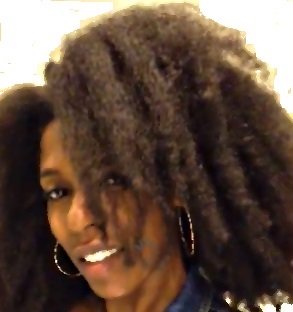
ABOUT THE AUTHOR: Melissa Lee
Melissa Lee is a Contributing Editor to NHP and a former owner of the BlackhairOMG website. She formed 4C Trichology Growth Services, LLC., a US based hair care consultation service. She has also contributed as a writer and consultant for various hair and beauty websites. Melissa can be followed on Twitter here.
